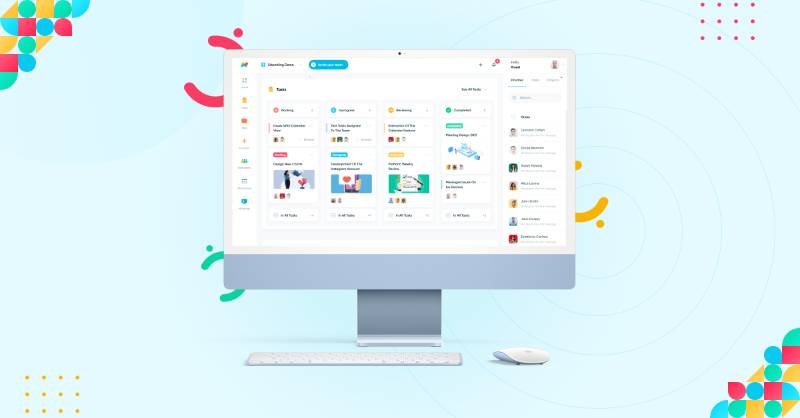Ah, performance management! Sounds a lot like corporate jargon, doesn't it? It's one of those phrases you hear in meeting rooms and corporate seminars. But what if I told you that performance management could be the hidden gem in your organization? It's not just about ticking off boxes in quarterly reviews or diving into spreadsheets that make your head spin. Nope, it's far more dynamic and deeply connected to the pulse of your team's engagement, productivity, and overall job satisfaction. Ready to revamp your prfrmnc management process? Then let's dive right in!
 Setting Realistic and Measurable Goals
Setting Realistic and Measurable Goals

The Cornerstone of Performance Management
So you want to amp up your team's performance, but where do you start? If you're aiming at a target, you need to know what that target is, right? Here's where goal setting comes into play. The main difference between a disengaged employee and an inspired one often comes down to whether they have a clear, achievable goal in sight. But beware! Goals that are too lofty or vague can be as detrimental as having no goals at all.
SMART Goals: The Compass Leading You Forward
The acronym "SMART" has become quite the buzzword, but there's a reason for that. It offers a structured approach to your objectives. Just a quick reminder: SMART stands for Specific, Measurable, Achievable, Relevant, and Time-bound. The SMART framework ensures you're not setting up your team for failure or setting goals that are too abstract.
- Specific: The more detailed, the better. "Increase sales by 20% in Q4" is far more effective than "sell more."
- Measurable: Use metrics to quantify your goals. This provides a yardstick for performance.
- Achievable: Setting impossible goals only demoralizes your team.
- Relevant: Make sure the goal aligns with broader company objectives.
- Time-bound: Deadlines create urgency and focus.

OKRs: Aligning the Ship with the North Star
Objectives and Key Results (OKRs) offer another method of structured goal-setting. OKRs allow teams to align their objectives with the company's strategic goals. The main difference between OKRs and SMART goals is that OKRs encourage a degree of "stretch," promoting ambition and innovation, while SMART goals prioritize achievable targets.
Would you set off on a cross-country road trip without a map or GPS? Likely not. Similarly, goal-setting provides the roadmap for your team's journey, ensuring everyone knows the final destination and the milestones along the way.
Technology as a Goal-Setting Partner
The days of scribbling goals on a notepad and stashing them in a drawer are long gone. Performance management software offers interactive platforms that make tracking goals a cinch. They provide real-time updates, encourage collaboration, and create an accountability structure.
How Tools like Asana and Monday Fit In

Performance management tools like Asana and Monday come equipped with dashboards, task management, and analytics features. The main difference between Asana and Monday lies in their user interface and customization options. Asana tends to offer more flexibility, while Monday offers more pre-set templates for different industry needs.
Whew! That's quite a bit to absorb, isn't it? But as the old saying goes, "Failing to plan is planning to fail." Setting goals is the linchpin in any robust performance management strategy. So, whether you're an ambitious startup or a corporate juggernaut, these pointers apply universally. And hey, there's more where that came from! Stick around for more tips and tools to rocket your performance management to the stratosphere.
 Employee Engagement: The Unsung Hero of Performance
Employee Engagement: The Unsung Hero of Performance

Why Engagement Matters More Than You Think
What if I told you that your employees' engagement levels are like the battery levels of a smartphone? A fully charged phone runs faster, right? Doesn't lag or hang up? Same goes for an engaged team. They're more productive, happier, and, yeah, they stick around longer. Here's the kicker: according to Gallup, highly engaged teams result in 21% greater profitability. No kidding!

The Emotional Quotient: Tapping into Team Sentiment
Imagine walking into a room full of lifeless faces staring at their monitors. Sounds dreadful, doesn't it? Your team's emotional well-being is pivotal. If they're unhappy, it trickles down into their work, impacting everything from quality to deadlines. Using emotional intelligence assessments or even simple surveys can provide invaluable insights. You can't fix what you don't know is broken, right?
The Intrinsic Vs. Extrinsic Motivation Debate

Employee motivation isn't one-size-fits-all. Some folks get a kick out of a job well done — that's intrinsic motivation. Others look forward to a bonus or promotion — hello, extrinsic motivation. The main difference between intrinsic and extrinsic motivation is their origin: internal satisfaction versus external rewards. Mixing up your motivational techniques is like seasoning a dish; you'll need a dash of both to keep things interesting.
Implementing Employee Engagement Strategies
Do you remember the last time you felt valued at work? How it put a pep in your step? Employee engagement isn't rocket science, but it's not a walk in the park either.
Recognition and Rewards: The Sizzle Before the Steak
Who doesn't like a pat on the back? Employee recognition programs, whether they are complex point systems or a simple "Employee of the Month" photo, can be instrumental. It's like telling your team, "Hey, we see you, and we appreciate you."
Flexibility: The New Norm
Remote work has revolutionized the way we perceive work-life balance. Allowing flexible work hours or remote days can breathe fresh air into a stifling work environment. It also shows your team that you trust them, which is priceless.
 Data-Driven Decision Making: Trust, But Verify
Data-Driven Decision Making: Trust, But Verify

The Power of Metrics
There's an old business adage: "What gets measured gets managed." In the age of Big Data, analytics offer a treasure trove of insights that can fine-tune your performance management strategies. No more guesswork or gut feelings; let's get empirical!
Key Performance Indicators: The Scoreboard of Success
KPIs (Key Performance Indicators) are your go-to metrics that give you a snapshot of how well you're doing. Sales figures, customer retention rates, and employee turnover ratios are some examples. These numbers act as a barometer for performance, letting you know when it's smooth sailing and when it's time to batten down the hatches.
Analytical Tools: The Magnifying Glass
From Google Analytics to Tableau, various software tools can dive deep into your data. They not only collect data but also visualize it in easily digestible formats. The main difference between these tools often lies in their user-friendliness and the specific kinds of data they are optimized to analyze.
 The Edworking Edge: A Unifying Force in Performance Management
The Edworking Edge: A Unifying Force in Performance Management

Look, we've been talking a lot about different facets of performance management—goal setting, employee engagement, and data analysis. But what if there was a tool that could bring all of these aspects together, neatly tied up with a bow? Enter Edworking.
This comprehensive all-in-one remote work platform is more than just a digital workspace; it's a catalyst for boosting your team's performance. How? Let's break it down:
- Task Management: Remember when we talked about SMART goals? Edworking allows users to manage different stages of projects, create and assign new tasks, and set deadlines. The unique feature integrating chat into tasks offers a significant advantage, allowing instant communication without switching platforms.
- File Sharing: In the world of data-driven decisions, being able to easily share and access data is paramount. Edworking's file sharing is intuitive and straightforward, providing flexible access rights.
- Docs: Modeled after Notion, this feature lets you create, share, and collaborate on documents in real-time, making it easier to align with company objectives and OKRs.
- Meetings: Remember the importance of employee engagement? Being able to integrate chat, video calls, and comments means you're always connected, thus negating the need for third-party services like Zoom or Skype.
- Stories: It's like your team's social network, encouraging engagement by allowing members to share progress and updates, making the work environment more transparent and connected.
And the cherry on top? All of these features are available at an affordable rate, starting at £1.5 per member per month, which minimizes costs while maximizing productivity.


 Conclusion
Conclusion
Alright, folks, let's land this plane! We've journeyed through the landscape of performance management, from the nitty-gritty of setting realistic goals to the importance of engaging your team emotionally and intellectually. We've also examined how data isn't just for the number-crunchers in the backroom but an invaluable tool that informs strategic decisions.
And yes, while individual strategies and tools like Asana, Monday, or even Google Analytics have their place, integrated platforms like Edworking offer a unified approach that could very well be the future of effective performance management.
So, where do we go from here? Well, the sky's the limit! Remember, a well-executed prfrmnc management process isn't a one-and-done deal. It's a dynamic, evolving practice that requires your attention, creativity, and commitment. It's like tending to a garden; with the right care, the fruits of your labor will be well worth the effort.
Ready to roll up your sleeves and revamp your prfrmnc management process? Your team, your stakeholders, and heck, even your bottom line will thank you for it. Go on, take that leap, and let's build workplaces that aren't just productive but are vibrant communities of engaged, satisfied individuals. Cheers to a future where work doesn't feel like work!







